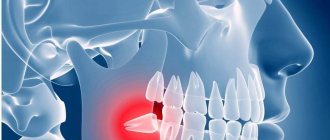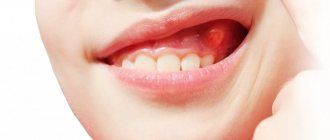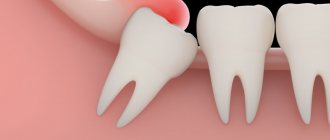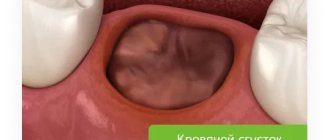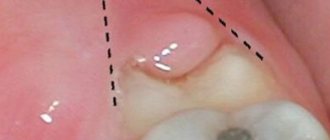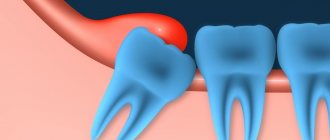Wisdom teeth (third molars, “eights”) are rightfully considered the most problematic teeth. For a rare lucky person, their eruption proceeds safely. After all, even if the number eight has enough space in the dentition - which is rather an exception in modern realities - while passing through the gums, this large multi-tubercular tooth causes a lot of suffering to its owner. That is why in America, for example, wisdom teeth are removed prophylactically, before eruption - even during their formation.
What problems can arise from wisdom teeth?
Reasons for the formation of pus in the gums
There are several reasons for the formation of pus:
- The inflammatory process causes a disease such as periodontal disease (gingivitis).
- Periodontal disease.
- Mechanical damage to the gums.
- Chemical or thermal burn.
- Unprofessional removal of tartar, which affected the gums.
- Extensive caries causes pulpitis.
- Failure to comply with hygiene standards when performing dental procedures.
- Unsanitary oral cavity.
- Types 1 and 2 diabetes mellitus.
- Summing up the causes of purulent inflammation of the gums, we can highlight the main factor that causes this disease – the vital activity of pathogenic microorganisms.
Treatment of tooth abscess at SM-Dentistry
The inflammatory process in the dental tissues will not go away on its own, and treatment at home is extremely ineffective and can only lead to the spread of infection. Therefore, we strongly recommend that at the first symptoms of tooth inflammation, you contact the nearest SM-Dentistry clinic. Highly qualified doctors, the latest dental methods and equipment, safe types of anesthesia make it possible to completely solve the problem of purulent inflammation of the tooth in the shortest possible time.
All types of abscesses are successfully treated at SM-Dentistry:
- gingival - with inflammation of the gums;
- periodontal - with a focus between the tooth and gum;
- periapical - affecting the pulp.
The treatment program depends on the extent of the infection, the nature and cause of the disease. Most often, it consists of cleaning the dental canals and pulp from pus, antibacterial therapy and tooth filling. If infection of the soft tissues of the oral cavity occurs, the intervention of a surgeon may be necessary to eliminate the source of infection while preserving the tooth. To make the treatment painless and comfortable for you, SM-Dentistry doctors use local or combined anesthesia with imported drugs.
After treatment, you will receive detailed recommendations on how to care for your teeth for effective healing. Within a day there will be significant relief.
Our specialists will also diagnose and eliminate dental diseases that caused the abscess. If necessary, you can consult doctors of related specialties.
If the abscess develops rapidly, contact SM-Dentistry at any convenient time. We work daily from 9:00 to 21:30, and on weekends until 21:00. To make an appointment, fill out an application on the website or call: +7 (495) 777-48-06.
Would you like us to call you back?
Dentist consultation Dental filling
Signs of pus and purulent inflammation
- severe pain in the area of the wisdom tooth; when you press on the gum, pus is released;
- redness of the gums and swelling;
- a large carious cavity is filled with softened soft tissue;
- colored plaque on the tooth and tartar;
- enlarged lymph nodes;
- change in facial contour. It becomes asymmetrical.
Causes
The main causes of tooth abscess can be considered:
- various untreated oral diseases (for example, cyst, pulpitis, caries and others);
- injuries to the jaw or mouth that led to the breaking off or fracture of a tooth;
- infection (brought in by blood);
- damage to the skin around the mouth or mucous membranes;
- the appearance of boils (on the skin) near the jaw;
- the appearance of infection due to drift during injections;
- poor oral hygiene.
Any tooth in the oral cavity is susceptible to an abscess, but those teeth that are involved in chewing food, as well as wisdom teeth, are most susceptible. An abscess is often accompanied by infections in the respiratory tract.
Symptoms
Experts call the following symptoms that accompany an abscess:
- acute pain (can be aching or throbbing);
- toothache when chewing;
- greater sensitivity of the tooth when exposed to temperature;
- bitter taste in the mouth;
- change in appetite;
- general malaise;
- discomfort accompanying a person;
- enlarged cervical lymph nodes;
- elevated temperature;
- the gums become red;
- the appearance of open ulcers with pus on the gums;
- swelling of the face near the jaw.
After the tooth root has died, the symptoms (not all) may disappear, but this is a temporary effect, since the infection will still develop.
It is possible that the abscess may open on its own. This means the transition of an acute to a chronic abscess, after which the symptoms subside. Chronic abscess is fraught with other exacerbations with complications.
Complications
Chronic abscess is the most harmless complication. Occurs with varying frequency. Chronic abscess is difficult to treat and can lead to complications.
A purulent tooth abscess is dangerous due to complications; if left untreated, the following may occur:
- Phlegmon is a tumor that does not have clear boundaries. Cellulitis is dangerous because it can be fatal. Requires surgical treatment.
- Sepsis is blood poisoning. Against the background of an infectious process, septic shock may develop in the patient’s body.
- A cyst is a benign tumor that tends to grow. It is useless to treat it with medication; surgical intervention is required.
- Meningitis is an inflammation of the membranes of the brain that affects a person’s mental state, leading to blindness, deafness and other serious consequences.
- Brain abscess - occurs because pathogens enter the brain, causing inflammation. The complication is difficult to treat and can lead to the death of the patient.
Treatment
Treatment is prescribed after a visual examination of the oral cavity and determination of the source of pus. Treatment of purulent inflammation can be:
- In a therapeutic way with the help of medicinal drugs.
- Physiotherapeutic.
- Surgery.
If purulent discharge does not stop after a course of therapeutic treatment, the doctor will prescribe surgery. Before the operation, plaque and tartar are cleaned and the mouth is disinfected.
An injection with a local anesthetic is injected into the gum and the gum is cut. The gum mucosa is cleaned of pus. If the fistula through which pus flowed is large, then a drainage is inserted. In the postoperative period, the patient is prescribed therapeutic treatment, which includes taking antibiotics and rinsing the mouth with a 0.05% chlorhexide solution, and is prescribed a complex of vitamins and minerals.
Every day, until complete healing, the patient must come to the dentist, where he is given an antibacterial application on the gum of the wisdom tooth. The patient must strictly follow all the dentist’s recommendations for oral care and consume only liquid foods.
Causes of dental inflammation
Bacterial damage to dental tissues can occur due to poor oral hygiene and insufficient patient attention to dental health issues. Among the common reasons:
- gum pathologies (periodontitis, periodontal disease, gingivitis);
- spread of caries;
- dental cysts, granulomas;
- cracks, chips on the tooth surface;
- oral injuries (for example, while eating);
- untimely change of toothbrush;
- poor quality teeth cleaning;
- weakening of the immune system.
However, the source of infection can be located in other parts of the body, and bacteria are carried into the gums by the bloodstream. Therefore, close attention should be paid to the treatment of any infectious diseases (especially ENT diseases) and increasing immunity.
Tooth abscess: what is it - symptoms and treatment
A dental abscess is an acute infectious pathology characterized by a clearly limited accumulation of pus in the root area. The purulent process is often a dangerous complication of periodontitis, periostitis, and other dental diseases. The lack of timely treatment threatens with adverse consequences not only for the affected segment, but also for the entire body. In Moscow, dental services are provided by the Center for Aesthetic Dentistry near the Otradnoye metro station. Our doctors will quickly and efficiently help eliminate any problem with sore teeth and gums.
Features of the structure and eruption of wisdom teeth
Unlike other teeth, the rudiments of “eights” are formed not during intrauterine development, but at 3–5 years, when the child’s body is preparing to change the primary dentition to a permanent one. At this age, you can determine the number of future eights (from one to four). However, it is impossible to detect possible developmental pathologies at this stage.
The crown part of third molars is formed at approximately 12 years of age, but the development of the root part takes several more years and can continue even after tooth eruption. Considering that the most common age for the appearance of third molars is 18–25 years, the eruption of wisdom teeth occurs already in adults. However, approximately 10 - 15% have no eights at all, which is why it is considered normal for an adult to have from 28 to 32 teeth.
How to help yourself at home
- Painkillers . Analgin, Nimesil, Ketoral will relieve pain for a couple of hours.
- Using gels and ointments to relieve inflammation. Children's gel Kalgel, Kamistad, Cholisal will provide the desired effect.
- Decoctions of medicinal herbs . Traditional ingredients - chamomile, sage, St. John's wort. Prepare the decoction for baths (pour into mouth, do not rinse).
- Antiseptics . An aqueous solution of Chlorhexidine, Furacillin or Miramistin is used for rinsing.
To relieve inflammation, you can prepare an antiseptic solution. Mix 1 tsp. soda and salt in a glass of water, mix, pour in 2-3 drops of iodine. Rinse your mouth with liquid 2-3 times a day.
It is forbidden to apply compresses to the inflamed gums or rinse with warm or hot water. Heating the affected area leads to dangerous complications.
Symptoms of gum abscess
The main symptom of the disease is pain. It has a different character (aching, pulsating, acute), is constant or occurs periodically under the influence of stress factors (cold, heat, sour, sweet foods). The pain is often worse when chewing. It can be local or spread to neighboring teeth, ears, eyes. In addition, with an abscess there are other clinical manifestations:
- hyperemia of soft tissues around the affected segment;
- swelling of the inflammation zone;
- bitter taste in the mouth;
- foul odor;
- mobility and change in the natural color of the segment;
- the presence of an ulcer on the gum with purulent discharge;
- enlargement of the submandibular lymph nodes;
- facial deformation due to swelling;
- hyperthermia, lethargy, sleep disturbance.
Features of professional help
After determining the cause of inflammation, a specific method of intervention is prescribed.
- Taking medications . Antibiotics are indicated for low-grade fever, enlarged lymph nodes, and spread of inflammation to adjacent tissues.
- Operation . It is carried out in case of pericoronaritis, incorrect positioning of the tooth, acute purulent pathologies.
- Dissection of the damaged gum . If the hood above the figure eight is inflamed, it is cut. It is carried out during prolonged tooth eruption.
- Novocaine blockade . Reduced symptoms of radiating pain.
- Physiotherapeutic techniques (laser exposure). Improvement of condition. Often prescribed in combination with other methods.
Difficulty erupting wisdom teeth
If there are the beginnings of eights, then there are two options: normal eruption of wisdom teeth or difficult. With the first option everything is very clear. But problems during teething may indicate the presence of pathologies - dystopic and impacted wisdom teeth.
Inflammation of the gum hood: types and form of the disease
According to the nature of the pathological process, chronic and acute pericoronitis are distinguished. Characteristic signs of chronic :
- Pain syndrome.
- Impaired chewing function.
- Formation of purulent formation.
- Periodic exacerbations.
- Mobility of dental elements.
The gum hood may become swollen due to inflammation of the soft tissues. Acute pericoronitis is expressed as follows:
- Pronounced pain syndrome.
- Presence of swelling and redness.
- Bad breath.
- Throbbing pain.
- Deterioration in general health.
Acute pericoronitis has the following types:
Catarrhal. The initial stage, when inflammation forms around the erupting element of the dentition. Swelling and pain when biting or chewing food may be observed.
Ulcerative. Characterized by the formation of lesions with a white coating. The clinical picture is expressed in bleeding, enlargement of regional lymph nodes. The patient may have pain in the hood above the tooth.
Purulent. Purulent contents are formed. Accompanied by severe pain, especially when swallowing and chewing food. In addition to the fact that the gum hood hurts, there may be a putrid odor from the mouth and a rise in temperature.
Posteriormolar. Inflammation near the wisdom tooth near the periosteum of the alveolar process of the jaw. The patient experiences pain when opening the mouth and chewing food. Treatment may require excision of the hood over the wisdom tooth, followed by cleaning the cavity and treating it with a special compound.
In all these cases, immediate contact with a specialist is required. Self-treatment leads only to temporary elimination of the symptoms of inflammation and increases the risk of complications.
